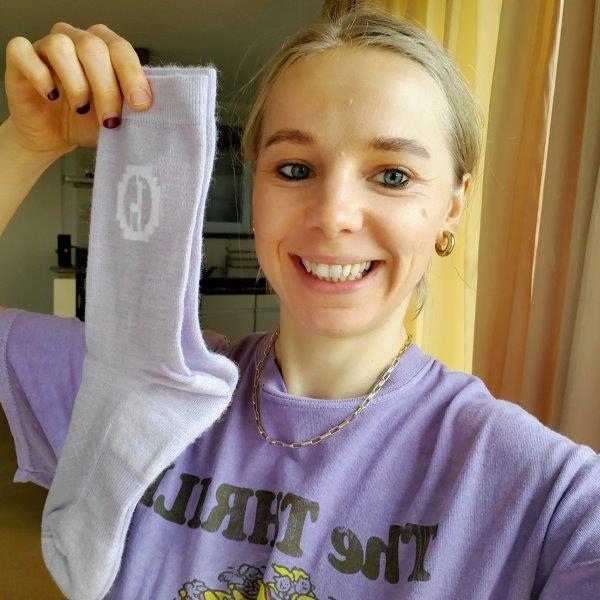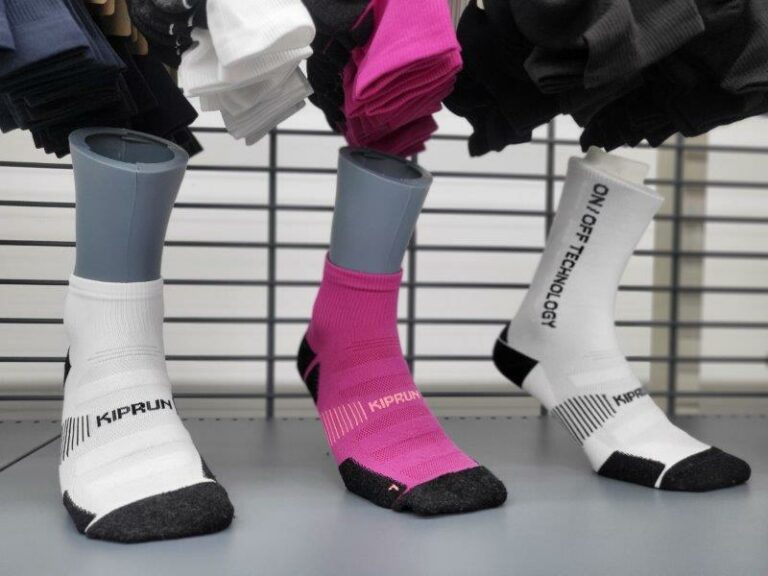We’ve all been there – Halfway through a trek, blisters start forming, and you’re left wondering if you could’ve prevented it.
Spoiler: you could’ve, with the right pair of socks.
It might surprise some, but the right socks are as crucial to an adventurer as a reliable compass or a sturdy pair of boots. In this article, we’ll share everything we’ve learned over the years about picking the perfect pair for your next adventure.

Quick Navigation
ToggleTypes of Socks
Socks come in a plethora of types, each designed with specific purposes, aesthetics, or functions in mind. The type you pick ultimately depends on your needs. For example, you wouldn’t wear dress socks to go hiking!
Here are the most common types of socks for adventurers:
Athletic Socks: Designed for physical activities like running, gym workouts, and sports. They often feature moisture-wicking materials, added cushioning in high-impact areas, and breathable zones.
Casual Socks: Made for everyday wear, these socks are versatile and come in numerous styles, materials, and patterns.
Hiking Socks: Built for durability and comfort, hiking socks often feature cushioning, and moisture-wicking properties, and are made of materials like wool to regulate temperature.
Winter or Thermal Socks: Designed for maximum warmth, they are usually thicker and made from insulating materials like wool.
Compression Socks: These socks provide graduated pressure on the legs to enhance blood circulation and reduce swelling, and are especially beneficial for those on their feet for extended periods.
Diabetic or Medical Socks: Designed to promote circulation, they typically have non-constricting bands and seamless toes. They help protect sensitive feet and reduce the risk of foot injuries, especially for diabetics.
No-show and Liner Socks: These are low-profile socks designed to be invisible or barely visible when worn with shoes. Liners are often very thin and can be worn under other socks for extra comfort or moisture management.
Cycling Socks: Specifically designed for cyclists, they offer moisture-wicking, breathability, and sometimes compression. They’re often ankle or crew length.
Water Socks: Designed to be worn in wet environments like beaches, rivers, or pools, they protect the feet from sharp objects and hot surfaces.
Toe Socks: Each toe is individually encased, much like fingers in a glove. They can help reduce friction between toes and are sometimes preferred by users of toe shoes.
Yoga and Pilates Socks: Featuring grips on the sole, these socks prevent slipping during practices on mats or studio floors.
Sock Features to Consider
Before simply grabbing the nearest pair of comfortable-looking socks, there are some features you need to consider. From material to fit, there are a lot of different factors to consider.
Sock Material
Socks are made from a variety of materials, each offering unique advantages and disadvantages based on their properties.

When selecting socks, it’s essential to consider the activity you’ll be doing. Daily wear, athletic activities, hiking, or cold-weather activities all have different requirements. By understanding the properties of each material, you can make an informed choice that ensures comfort and durability.
Here are some pros and cons for materials you’ll likely see listed on a pair of socks:
Cotton
Pros:
- Soft and comfortable to wear
- Absorbs moisture well
- Breathable and suitable for warmer weather
Cons:
- Retains moisture once wet, which can lead to blisters in rigorous activities
- Less insulating, so not as warm in colder conditions
- Tends to wear out faster than some other materials
Wool
Pros:
- Excellent insulator; keeps feet warm in cold conditions
- Naturally moisture-wicking, pulling sweat away from the skin
- Reduces odor due to its antimicrobial properties
- Can retain warmth even when wet
Cons:
- Some people may find wool itchy, though merino wool is softer and less irritating
- Tends to be bulkier
- Can shrink if not cared for properly
Synthetics (Polyester, Acrylic, Nylon, Spandex, etc.)
Pros:
- Lightweight and dries quickly
- Maintains shape well
- Can be blended with other materials to enhance certain properties
- Often used for performance or athletic socks due to moisture-wicking capabilities
Cons:
- Less naturally breathable than materials like cotton or wool
- Depending on the synthetic, might retain odors more than natural fibers
Silk
Pros:
- Extremely soft and lightweight
- Naturally hypoallergenic
- Used in liner socks to prevent blisters
Cons:
- Not very durable; wears out quickly
- Absorbs moisture but doesn’t wick it away effectively
- Less insulating
Bamboo
Pros:
- Soft and silky feel
- Naturally antibacterial and antifungal
- Eco-friendly, as bamboo is a renewable resource and biodegradable
- Breathable and wicks moisture away
Cons:
- Might wear out faster than some synthetic materials
- Can be a bit pricier than other materials
Blends
Many socks today are made from blends of several materials to harness the benefits of each. For example, a sock might be primarily made of wool for its insulating and moisture-wicking properties but include a percentage of spandex for stretch and fit.
You’ll have to consider the percentages of material in blended socks to make sure you get the features you need.
Sock Height
Socks come at different heights depending on their purpose and need. From no-shows to knee-highs, each length serves a different need.

No-show or Invisible
These socks are hidden inside shoes, making them ideal for loafers, low-cut sneakers, or any footwear where you might not want the sock to be visible. They often have a silicone grip on the heel to prevent them from slipping down.
Ankle or Low-Cut
These socks sit just at or slightly above the ankle. They’re used for running or casual wear with sneakers.
Quarter
These rise a little above the ankle but do not cover the shin. They tend to offer more protection against shoe rub and are often used in athletic settings.
Crew
A very popular height, crew socks typically extend to the mid-calf. These socks are versatile in use, from everyday casual wear to hiking.
Mid-Calf
As the name suggests, these reach halfway up the calf. They’re often used in formal wear or for particular sports.
Knee-High
These socks extend all the way to just below the knee. They’re common in certain sports, for cold weather, or as a fashion statement. They’re also often recommended for travel to promote circulation.
Over-the-Knee and Thigh-High
These socks surpass the knee, with thigh-highs reaching up to the mid-thigh. They’re often more fashion-oriented or used in colder climates for added warmth.
Sock Thickness
Have you ever considered your sock’s thickness? After all, you wouldn’t want to wear thick, wool socks in the middle of summer! There are many different benefits to different sock thicknesses.
Ultra-Thin or Lightweight: Provide minimal cushioning. Ideal for close-fitting shoes or warmer weather.
Thin or Light Cushion: Slightly more cushioning than ultra-thin socks, but still relatively lightweight. Often used in running shoes or casual footwear.
Medium Cushion: A balanced amount of padding, commonly found in hiking and everyday socks. Offers more protection against impact and insulation against cold.
Thick or Heavy Cushion: Provides maximum padding and insulation. Ideal for cold weather, extended treks, or when using boots.
Variable Thickness: Some specialized socks have variable thickness, offering more padding in high-impact areas like the heel and ball while being thinner in other sections.
Sock Fit
One of the most important factors when it comes to socks is their fit. The perfect sock doesn’t matter much if you can’t fit it right on your foot!
Here are the most important factors to consider when it comes to getting the right fit for your socks:
Size: Just like shoes, socks come in various sizes. It’s essential to choose the right size for your feet to prevent them from being too tight or too loose, which can lead to friction, blisters, or discomfort.
Elasticity: A good sock should have the right amount of elasticity to ensure it stays up without cutting off circulation. This is often achieved through the addition of materials like elastane or spandex.
Toe Box: The toe area should provide ample room for your toes to move without excessive material that can bunch up and cause discomfort.
Heel Pocket: A well-designed sock will have a clearly defined heel area, ensuring the sock sits correctly on the foot and provides appropriate cushioning and support.
Arch Support: Some socks feature a tighter weave or elastic in the arch area, providing added support and helping distribute foot pressure more evenly.
Extra Features
Some socks come with extra features that attract certain adventurers. Here are some of the most popular features we’ve seen that might draw you in:
Moisture-Wicking: This feature draws sweat away from the foot, helping keep it dry and reducing the risk of blisters or fungal infections. Materials like merino wool or certain synthetics offer this benefit.
Breathability Zones: Some socks, especially athletic ones, incorporate mesh zones or areas with a more open weave to increase ventilation.
Seamlessness: Seamless socks are constructed without seams or with very flat ones, reducing potential friction points that can cause blisters.
Antimicrobial/Anti-Odor: Some socks are treated or made with materials that have antimicrobial properties, reducing the growth of bacteria and, thus, foot odor. Merino wool is a great example of this.
Waterproofing: Though less common, there are waterproof socks designed to keep feet dry in wet conditions. They often have multiple layers, including a waterproof membrane.
Double-layered: Some socks have a dual-layer construction to reduce friction between the foot and the shoe to minimize the risk of blisters.
Grip Enhancements: Socks for activities like yoga or pilates might have rubberized grips on the sole to prevent slipping.
Reflective Elements: For those active during low-light conditions, some athletic socks have reflective strips or patterns to enhance visibility.
Choosing the Right Sock for Your Adventure
Every adventure is different – that’s why you’ll need different socks, too. Here are the top features you should get in your socks depending on the type of adventure you’re going on.
Hiking & Trekking
Terrain and Climate: For rough terrains or long treks, opt for socks with additional cushioning, especially in the heel and ball of the foot. For colder climates, wool provides warmth, while in warmer climates, a lighter, moisture-wicking sock is preferable.

Length: Based on personal preference and the type of boot you wear. Higher boots, like cold weather hunting boots, generally require crew-length or knee-high socks.
Thickness: This depends on your boot fit. Ensure there’s no excessive tightness with thicker socks.
Running
Material: Synthetic materials often wick moisture better, reducing blister risk.
Cushioning: Some prefer thin socks for a better shoe fit, while others opt for additional cushioning for shock absorption.
Fit: It should be snug to prevent friction and the formation of blisters.
Climbing
Thickness: A thinner sock can improve shoe sensitivity, but ensure it still offers protection against potential pressure points.
Material: Moisture-wicking is essential, as sweaty feet can lead to reduced friction and grip inside the climbing shoe.
Winter Sports (Skiing, Snowboarding)
Material: Wool or wool blends are favorites due to their warmth and moisture-wicking properties.
Cushioning: Look for socks with cushioning in the shin and calf areas for added comfort against boot pressure.
Fit: A snug fit is crucial. Loose socks can bunch up and cause discomfort or cold spots.
Water Activities (Kayaking, Canyoning, Rafting)
Material: Neoprene socks are ideal for insulation when wet. For activities where you might be in and out of the water, consider quick-drying materials.
Thickness: Depending on the water temperature, you might want thicker neoprene.
Desert or Beach Excursions
Material: Breathable and moisture-wicking materials are crucial. Sand can become an irritant if trapped inside the sock.
Length: Consider higher socks to prevent sand from getting inside.
Biking
Padding: Look for socks with padding in areas of pressure, such as the ball of the foot.
Material: Synthetic blends often provide excellent moisture-wicking, keeping feet dry and comfortable.
Length: Based on personal preference and the type of biking. MTB riders might prefer longer socks, while road cyclists might opt for ankle-length.
Everyday Adventure (Touring, City Exploration)
Material: Cotton or blends can be suitable for comfort, but ensure some moisture-wicking capabilities if walking extensively.
Cushioning: Light to medium, depending on the amount of walking and shoe type.
Final Thoughts
The right pair of socks can keep you comfortable all day long while exploring the great outdoors. When in doubt, always look for features that fit best for the activity you plan to participate in.
If you’re on the hunt for a new pair of socks, check out some of our product reviews for socks below.


